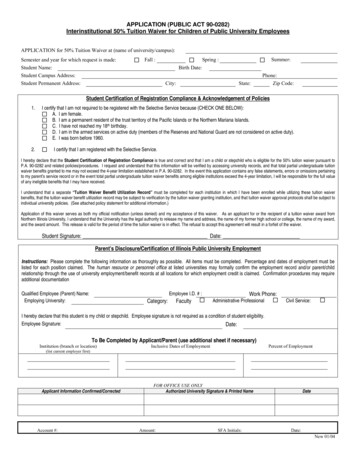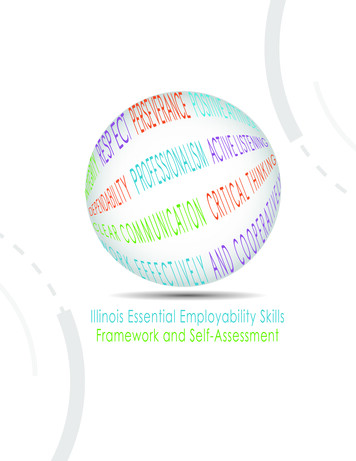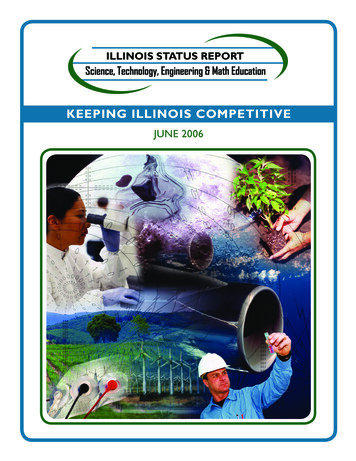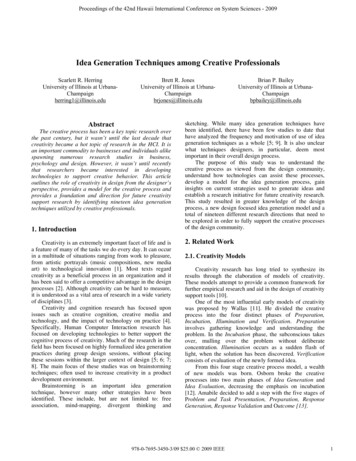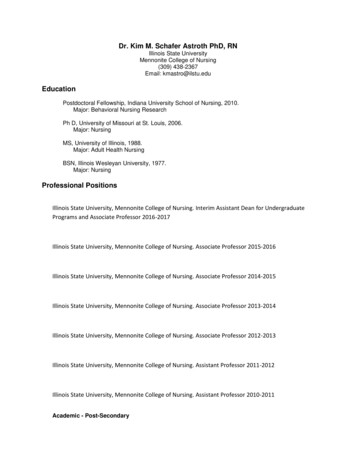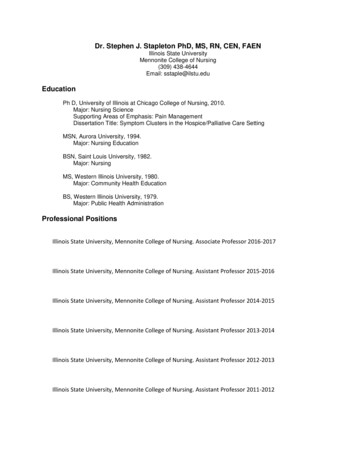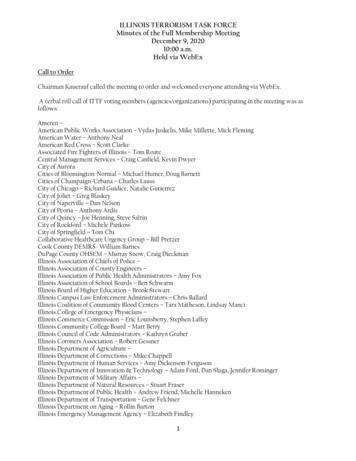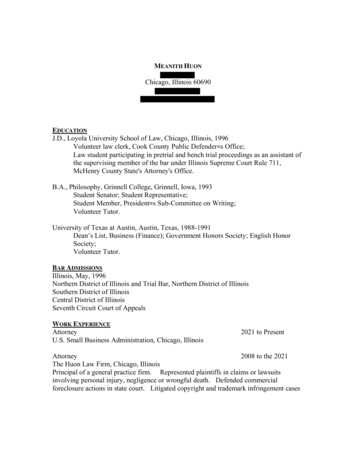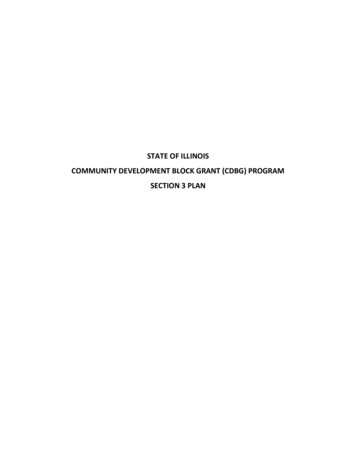
Transcription
STATE OF ILLINOISCOMMUNITY DEVELOPMENT BLOCK GRANT (CDBG) PROGRAMSECTION 3 PLAN
Table of ContentsOverview . 1Definitions . 1Requirements of Section 3. 2Applicability of Section 3. 2Section 3 Goals/Benchmarks . 3Grantees Responsibilities. 3Outreach Best Practices . 4Procurement and Bid Documents. 4Priority Considerations . 4Making Connections . 5Penalties for Non-Compliance . 6Section 3 Reporting Requirements . 6Steps for Complying . 8APPENDIXSection 3 Clause . 1Contractor’s Requirements . 2Intent to Comply with Section 3 Requirements. 3Certification of Bidder Regarding Section 3 and Segregated Facilities . 5Contractor Permanent Workforce Form . 6Section 3 Worker Certification Form . 7Section 3 Business Concern Certification Form . 8Section 3 Business Owner Certification Form . 9Section 3 Compliance – Target Section 3 and Section 3 Worker Tracking Report . 10Final Section 3 Utilization Report. 11Safe Harbor Compliance Report . 12Notice to Citizens . 13State of Illinois CDBG Program – Section 3lTable of Contents
Illinois WorkNet Center Map . 14Illinois Regional Workforce Centers. 15Examples of Efforts to Award Contracts to Section 3 Businesses. 16Examples of Efforts to Offer Training and Employment Opportunities to Section 3 Workers . 1724 CFR Part 75 . 18Additional Section 3 Information & Resources . 25State of Illinois CDBG Program – Section 3lTable of Contents
OVERVIEWThis Plan, put forth by the Illinois Department of Commerce & Economic Opportunity (DCEO), whichadministers the Community Development Block Grant (CDBG) Program, describes Section 3 of the Housingand Urban Development Act of 1968, as amended, (12 U.S.C. 1701u) ("Section 3") and its applicability to theState of Illinois CDBG-funded projects administered by DCEO.Section 3 requires that economic opportunities generated by certain U.S. Department of Housing and UrbanDevelopment (HUD) financial assistance for housing and community development programs be directed tolow- and very low-income persons. The priority of assistance should be to those who are recipients ofgovernment assistance for housing and business concerns which provide economic opportunities to lowand very low-income persons.The Section 3 program was created to ensure that persons living in communities where HUD-assistedprograms were being funded could economically benefit from the resources being spent. This wouldimprove the overall socioeconomic condition of not only the community, but also the low- and very lowincome residents within the neighborhoods.The implementing regulation for Section 3 can be found at 24 CFR Part 75.The State of Illinois’ CDBG Program, administered by the Illinois Department of Commerce and EconomicOpportunity (DCEO), the Department, shall comply with Section 3 requirements set forth at 24 CFR 75 ofthe federal regulation which states that, to the greatest extent possible, businesses and employersworking on HUD-funded projects must make a good faith effort to train and employ low-incomeindividuals living in the local area and to contract with businesses owned by or that employ Section 3workers.DEFINITIONSA Section 3 project means housing rehabilitation, housing construction, and other public constructionprojects assisted under HUD programs that provide housing and community development financialassistance when the total amount of assistance to the project exceeds a threshold of 200,000. Thethreshold is 100,000 where the assistance is from the Lead Hazard Control and Healthy Homes programs,as authorized by Sections 501 or 502 of the Housing and Urban Development Act of 1970 (12 U.S.C. 1701z1 or 1701z-2), the Lead-Based Paint Poisoning Prevention Act (42 U.S.C 4801 et seq.); and the ResidentialLead-Based Paint Hazard Reduction Act of 1992 (42 U.S.C. 4851 et seq.). The project is the site or sitestogether with any building(s) and improvements located on the site(s) that are under common ownership,management, and financing.A Section 3 worker is any worker who currently fits, or when hired within the past five years fit, at leastone of the following categories, as documented:(1) The worker’s income for the previous or annualized calendar year is below the income limitestablished by HUD(2) The worker is employed by a Section 3 business concern(3) The worker is a YouthBuild participant.A Targeted Section 3 worker: any worker who currently fits, or when hired within the past five years fit, atleast one of the following categories, as documentedState of Illinois CDBG Program – Section 3 PlanPage 1
(1) A worker employed by a Section 3 business concern, or(2) Currently fits or when hired fit at least one of the following categories, as documented within thepast five years:(i) Low- or very low-income workers residing within a one-mile radius of the Section 3 project. Iffewer than 5,000 people live within that one-mile radius, the circle may be expanded outwarduntil that population is reached or the neighborhood of the project, as defined; or(ii) A YouthBuild participant.A Section 3 Business Concern is a business that meets at least one of the following criteria, documentedwithin the last six-month period: It is at least 51 percent owned and controlled by low- or very low-income persons;Over seventy-five (75) percent of the labor hours performed by the business are performed bylow- or very low-income persons; orIt is a business at least 51 percent owned and controlled by current public housing residents orresidents who currently live in Section 8-assisted housing.The Service Area or “neighborhood of the project” is defined as an area within one mile of the Section 3project or if fewer than 5,000 people live within one mile of the project, within a circle centered on theproject location that is sufficient to encompass a population of 5,000 people according to the most recentU.S. Census.REQUIREMENTS OF SECTIONS 324 CFR Part 75 requires, to the greatest extent feasible, and consistent with existing, federal, state, andlocal laws and regulations, economic opportunities resulting from HUD financial assistance includingemployment, job training, and contracting are directed to low- and very low-income persons. Theregulations seek to ensure that public housing residents and low- and very low-income persons, and thebusinesses that employ these individuals, are notified about the expenditure of HUD funds in theircommunity and encouraged to seek opportunities, if created.It is the policy of Illinois’ CDBG Program that all Grantees are required to make good faith efforts to provide "tothe greatest extent feasible" opportunities to Section 3 area workers and Section 3 business concerns.APPLICABILITY OF SECTION 3In accordance with 24 CFR Part 75, whenever any portion of CDBG funding is invested into projectsinvolving housing construction, demolition or rehabilitation, commercial/private improvements foreconomic development, or other public construction (e.g., roads, sewers, community centers, and publicfacilities), the requirements of Section 3 may apply, based on the guidance provided below.Section 3 requirements that apply to CDBG funded Projects:In conjunction with construction activity, Section 3 applies to projects that receive 200,000 or more inCDBG assistance, including projects that are financed in conjunction with state, local, or private matchingor leveraged funds, provided that the Section 3 monetary threshold requirements are met. In particular: Section 3 applies to CDBG Grantees, and Contractors and subcontractors working on CDBG-grantState of Illinois CDBG Program – Section 3 PlanPage 2
funded projects. Professional service contract labor hours (construction contract oversight, engineering,architectural, environmental and property evaluation, construction progress and constructiondraw inspection, and prevailing wage labor compliance) are not required to be reported. If acontract covers both professional services and other work and the recipient, contractor, or subcontractor chooses not to report labor hours from professional services, the labor hours under thecontract that are not from professional services must still be reported. Section 3 requirements do not apply to material supply contracts. The regulations should not be construed to mean that recipients are required to hire Section 3Workers or award contracts to Section 3 Business Concerns other than what is needed tocomplete covered projects and activities.If the expenditure of funding for an otherwise covered project and activity does not result in newemployment, contracting, or training opportunities, reporting is still required.SECTION 3 GOALS/BENCHMARKSSection 3 goals will be applied to CDBG-funded project as follows:Contractors and sub-contractors will be required, to the greatest extent feasible, meet both of the Section3 HUD benchmarks.1. Twenty-Five (25) percent or more of the total number of labor hours worked by all workers on aSection 3 project are Section 3 workers.2. Five (5) percent or more of the total number of labor hours worked by all workers on a Section 3project are Targeted Section 3 workers.If these benchmarks are not met, the Grantee and contractors must report on activities pursued in theabsence of not meeting Section 3 benchmarks.GRANTEE’S RESPONSIBILITIES TO ENSURE COMPLIANCEA local government that receives CDBG funding has the responsibility to comply with Section 3 requirementsin its own operations and ensure compliance in the operations of its contractors/subcontractors. Thisresponsibility includes:1. Notifying Section 3 Workers and business concerns about jobs and contracts generated by Section3 covered assistance so that they may submit bids/proposals for available contracts and jobopenings with the grantee.2. Notifying potential contractors of their responsibilities under Section 3.3. Including Section 3 language in all applicable contracts.4. Requiring sub-recipients, contractors, and sub-contractors to meet the requirements of §75.19,regardless of whether Section 3 language is included in recipient or sub-recipient agreements,program regulatory agreements, or contracts.5. Documenting action(s) taken to meet the HUD benchmarks.6. Responding to Section 3 complaints.State of Illinois CDBG Program – Section 3 PlanPage 3
7. Completing and submitting the required Section 3 Forms to the Department.OUTREACH BEST PRACTICESGrantees must develop a Section 3 Plan, including outreach to Section 3 Workers and Businesses withinthe municipality. Best practices include:1. Publication of opportunities in newsletters or other local newspapers, including those targeted toLimited English Proficient populations.2. Use of signage at the project site and flyers posted in the project area.3. Notification of potential training or employment opportunities to neighborhood and non- profitgroups, including Public Housing Authorities, servicing low- and very low-income persons.4. Communicate opportunities to employment agencies and career centers. Use “Notice to Citizens Opportunity for Work,” included in the Appendix to this Plan. Sendthe completed form to your local Illinois WorkNet/American Jobs Center. A list of the IllinoisComprehensive WorkNet/American Job Centers and a regional map to aid in locating theappropriate center for your area are also provided in the Appendix. A copy of thecompleted form and proof of submission should be submitted with the Pre-constructionConference Checklist to document outreach efforts.PROCUREMENT & BID DOCUMENTSCDBG recipients must include Section 3 language in all procurement and bid documents. The requiredlanguage to be included in these documents can be found in the Appendix to this Plan, titled “Section 3Clause”. In addition to the Section 3 Clause, Grantees must include the “Intent to Comply with Section 3”and the “Contractor’s Requirements” forms with all bid documents.PRIORITY CONSIDERATIONSCDBG Grantees and contractors shall provide priority consideration to Section 3 residents and Section 3businesses for new training, employment, and contracting opportunities generated as a result of theexpenditure of Section 3 covered financial assistance. Priority consideration should not be construed to be a quota or set-aside program, or asan entitlement to economic opportunities such as a particular job or contract.Section 3 residents must possess the same job qualifications, skills, eligibility criteria, andcapacity as other applicants for employment and training opportunities being sought.Section 3 businesses must be selected in accordance with the procurement standards of 2CFR 200, as appropriate, including price, ability and willingness to comply with Section 3,and other factors, to be considered lowest responsible bidders on contractingopportunities being sought.Priority consideration may be given to a Section 3 resident or business if such resident orbusiness is qualified for the respective employment or contracting opportunitiesPriority consideration must be given to a Section 3 resident or business when that Section3 resident or business is equally qualified with other individuals or businesses that wouldbe offered employment or contracting opportunities.State of Illinois CDBG Program – Section 3 PlanPage 4
Employment and TrainingCDBG Grantees that meet the funding thresholds shall direct their efforts to provide training andemployment opportunities generated from the expenditure of Section 3 housing and communitydevelopment financial assistance to Section 3 residents in the following order of priority consideration:1.2.3.Section 3 residents residing in the neighborhood or service area where the housing andcommunity development financial assistance is spent.Section 3 residents participating in DOL Youth Build programs.Other Section 3 residents.ContractingGrantees and contractors shall direct their efforts to provide contracting or subcontracting opportunitiesgenerated from the expenditure of housing and community development financial assistance to Section 3businesses in the following order of priority consideration:1.2.3.Section 3 business concerns that provide economic opportunities for Section 3 residentsin the service area or neighborhood where the Section 3 covered project is located.Applicants selected to carry out DOL Youth Build programs.Other Section 3 business concerns.MAKING CONNECTIONSThe Section 3 Business Registry and Opportunity Portal are two online registries that connect Section 3Workers to training and employment opportunities and Section 3 businesses to contracting opportunities.Businesses who self-certify that they meet one of the regulatory definitions of a Section 3 business will beincluded in a searchable online database. The database can be used by agencies that receive HUD funds,developers, contractors, and others to facilitate the award of covered construction and non-constructioncontracts to Section 3 businesses. Section 3 Workers are encouraged to use the Opportunity Portal toidentify businesses that may have HUD- funded employment opportunities available. Section 3 businessesare encouraged to post training, employment, and contracting opportunities to the Opportunity Portal.CDBG recipients should utilize HUD’s Section 3 Business Registry to find Section 3 businesses that may beable to participate in the CDBG project.Recipients can search through HUD’s Section 3 registry ry/SearchBusinessBusinesses may register as a Section 3 Business through HUD’s website ry/RegisterBusinessThe Opportunity Portal can be accessed through HUD’s website here:https://hudapps.hud.gov/OpportunityPortal/It is important to note that Section 3 businesses are not entitled to receive contracts simply by being listedin HUD's Section 3 Business Registry database or Opportunity Portal.State of Illinois CDBG Program – Section 3 PlanPage 5
PENALTIES FOR NON-COMPLIANCECDBG Grantees have the responsibility of complying with Section 3 regulations and ensuring complianceamong its contractors and subcontractors. Federal code established penalties for Section 3 violations andnon-compliance (24 CFR Part 75 135.38(f)).Failure to comply with the requirements of Section 3 may result ina monitoring finding or sanctions that may include: Debarment or suspension of funds Termination of Grant Agreement/Contract Limited denial of participation in State of Illinois CDBG programs.SECTION 3 REPORTING REQUIREMENTSReporting of Labor Hours - Recipients must report in a manner prescribed by HUD: The total number of labor hours worked; The total number of labor hours worked by Section 3 workers; and The total number of labor hours worked by Targeted Section 3 workers.For all projects employing Section 3 workers, the Grantee, contractor/s must maintain one of thefollowing (in order of priority) to demonstrate Section 3 status of the worker:1. Worker income self-certification: Through the use of Section 3 Worker Certification Formprovided to contractors and subcontractors working on the project. Each worker on the projectmust complete the provided certification form to be kept in the grant record for reference whentracking and aggregating labor hours worked.2. Worker is employed by a Section 3 Business Concern: The contractor or subcontractor is able toprovide documentation that it qualifies as a Section 3 Business Concern. All employees of aqualifying business will be considered Section 3 workers.3. Worker is a Youthbuild participant: Verifiable documentation must be provided by the worker orthe employer showing the worker is participating in a Youthbuild program.4. Employer wage record: The employer is able to provide certified documentation that the worker'sincome from that employer is below the income limit for the corresponding family size whenbased on an employer's calculation of what the worker's wage rate would translate to ifannualized on a full-time basis. Submit documentation with the Contractor’s PermanentWorkforce Form located in the Appendix to this Plan.NOTE: Documentation submitted by employers should only contain employee names, state andcounty of residence, annual income, and a certifying signature and date. Do not include anyinformation such as social security numbers or bank account information.Nothing in the regulations shall be construed to require the employment of someone who meets thedefinition of a Section 3 worker. Section 3 workers are not exempt from meeting the qualifications of theposition to be filled.Contractors or subcontractors who wish to be identified as a Section 3 Business must complete theSection 3 Business Self-Certification form included in the Appendix to this Plan and provide requestedState of Illinois CDBG Program – Section 3 PlanPage 6
backup documentation.While contracting and subcontracting with Section 3 Business Concerns is encouraged, nothing in theregulations shall be construed to require the contracting or subcontracting of a Section 3 BusinessConcern. Additionally, Section 3 Business Concerns are not exempt from meeting the specifications of thecontract, including required licensures and certifications.Businesses seeking Section 3 preference shall certify, or submit evidence to the Grantee, contractor, orsubcontractor (if requested) verifying that they meet the definitions provided above. Grantees are alloweddiscretion to determine the required documentation to verify a Section 3 Business Concern. Atmonitoring, the Department will check that documentation has been received and is in the file, not for aspecific type of documentation.Note: If a business meets the definition of a Section 3 business, it is encouraged to register as a Section 3Business through HUD’s Business Registry ry/RegisterBusinessBusinesses who self-certify that they meet one of the regulatory definitions of a Section3 Business Concern will be included in a searchable online database. The database can be used byagencies that receive HUD funds, developers, contractors, and others to facilitate the award of coveredconstruction and non-construction contracts to Section 3 Business Concerns.The Section 3 Contractor’s report is a tool to be used to track Section 3 and Targeted Section 3 WorkerHours on CDBG funded projects. This spreadsheet should be maintained through the duration of theproject. Recipients will be asked to provide DCEO with Section 3 and Targeted Section 3 Worker hours foreach project, as well as other non-qualitative activities conducted to comply with Section 3 requirements.Recipients will provide this spreadsheet to DCEO as documentation of compliance with Section 3 reportingrequirements. Even if no Section 3 Workers were utilized, this report must be completed and submitted toDCEO at the completion of the project.Safe Harbor Compliance - Additional reporting is required if Section 3 benchmarks are not met. If theGrantee’s reporting under paragraph (a) of the Regulations indicates that the recipient has not met theSection 3 benchmarks described in § 75.23, the recipient must report in a form prescribed by HUD on thequalitative nature of its activities and those its contractors and subcontractors pursued.The Grantee and each contractor working on the project must complete the Safe Harbor ComplianceForm, which must be maintained in the project file and submitted with the grant closeout package. TheQualitative efforts will be reported to HUD at the closeout of the grant-funded project.Annual ReportingDCEO will report to HUD an aggregate of all labor hours worked, all labor hours worked by Section 3workers, and all labor hours worked by Targeted Section 3 workers for all projects completed annually.This report will cover program year activities from January 1 to December 30. For projects that do notmeet the Section 3 accomplishments, DCEO must report the qualitative efforts under Safe HarborCompliance. This data will be collected using the Contractor’s Report and the Safe Harbor Complianceforms, if applicable, submitted at the time of closeout.State of Illinois CDBG Program – Section 3 PlanPage 7
STEPS FOR COMPLYING1. Include Section 3 language in all advertisements for RFQ/RFP and bid documents.2. Check HUD registry for Section 3 businesses located in the county in which the project is taking try/What. Check Illinois’ Disadvantaged BusinessRegistry as part of the Business Enterprise Program (BEP) (State of IL Central Management Services(CMS) (diversitycompliance.com) ) for potential bidders within the service area and share CDBG bidopportunities with those businesses. Keep documentation of any correspondence with Section 3businesses.3. Submit employment opportunities to Illinois WorkNet agencies and HUD’s Opportunity Portal; CheckOpportunity Portal for Section 3 Workers when filling open employment opportunities.4. Include the “Contractors Requirements” and “Intent to Comply with Section 3 Requirements” formswith all procurement documents. “Intent to Comply with Section 3 Requirements” form must besigned by bidders and returned with bid documents.5. If a Section 3 business submits a bid for an opportunity associated with the CDBG project, the Granteemust give priority to the greatest extent feasible. Refer to Priority Considerations for Contracting in thisPlan for the order of priority that Section 3 businesses should be given.6. Describe Section 3 requirements at pre-bid meeting and the pre-construction conference. Documentthrough notes, official meeting minutes, etc. that this discussion took place and provide all requiredmaterials to the contractor/s.7. Include Section 3 language with ALL contracts and subcontracts associated with the CDBG contract.8. At the time the Grantee and contractor enter an agreement, identify if any employment/trainingopportunities will result from the CDBG funded project.a) Post signs advertising employment, training, or subcontracting opportunities that will beavailable as a result of the Section 3 projects and activities in conspicuous places at the work sitewhere potential applicants can review them.b) Send notice of the opportunities to the Illinois WorkNet local job center, and HUD’s opportunityportal. Use Section 3 Employment Notice provided in this Plan. See Additional efforts that maybe taken to reach Section 3 workers.c) Inform contractors/subcontractors of hiring and training preferences to be given to Section 3workers and order of priority as described in this Plan.d) Provide “Section 3 Contractor’s Report,” “Section 3 Business Certification,” and “Section 3Worker Certification” to contractor/subcontractors to document Section 3 Businesses andWorkers.e) Use submitted Section 3 Worker Certification forms to identify which workers are Section 3workers and Targeted Section 3 workers. All hours worked, the hours worked by Section 3workers and Targeted Section 3 workers must be reported to DCEO.9. Collect Section 3 data on a per project basis from every contractor and subcontractor using the“Section 3 Contractor’s Report.”10. Maintain documentation of qualitative efforts by the Grantee and contractors andsubcontractors to engage Section 3 workers in employment and training opportunities and tocontract with Section 3 Business Concerns for reporting of Safe Harbor Compliance when theSection 3 Goals/Benchmarks are not met.11. Keep documentation of all Worker, Employer and Business Certifications, as well as outreachefforts to Section 3 Businesses and Section 3 Workers, on file for project monitoring.12. Submit Section 3 Contractor’s Report and Safe Harbor Compliance form to DCEO at the time ofproject closeout (not including leverage funded activities).State of Illinois CDBG Program – Section 3 PlanPage 8
Section 3 ClauseAll Section 3 covered contracts shall include the following clause (referred to as the Section 3 Clause):A. The work to be performed under this contract is subject to the requirements of Section 3 of theHousing and Urban Development Act of 1968, as amended, 12 U.S.C. 1701u (Section 3), contributes tothe establishment of stronger, more sustainable communities by ensuring that employment and othereconomic opportunities generated by Federal financial assistance for housing and communitydevelopment programs are, to the greatest extent feasible, directed toward low- and very low-incomepersons, particularly those who receive Federal financial assistance for housing and those resid
SECTION 3 PLAN. State of Illinois CDBG Program - Section 3 Table of Contents . government assistance for housing and business concerns which provide economic opportunities to low- . The Section 3 program was created to ensure that persons living in communities where HUD-assisted programs were being funded could economically benefit from .
